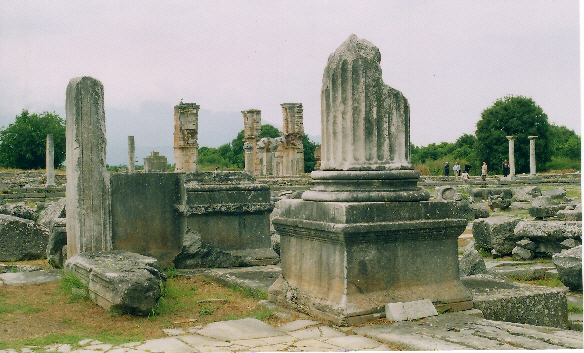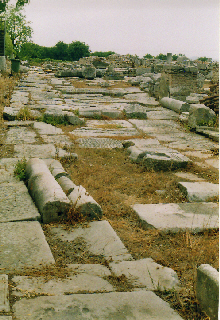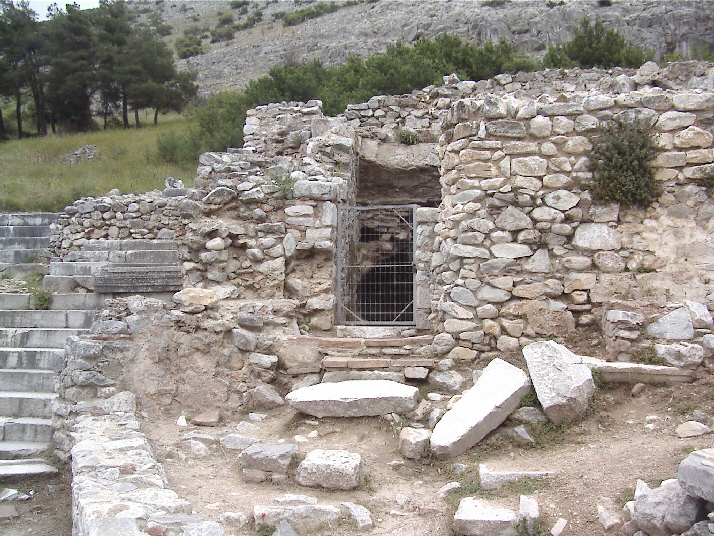|
Journey through Ancient Greece
Philíppi
Philíppi
(also spelt Philíppoi, Filíppoi or Filípi) is 15
kilometres north of Kavala. The archaeological remains
here are mostly from the Roman and Byzantine
periods of the city's history. The theatre is the only
major building to have been excavated from the time of
Philip II.
|
 |
|
History
The city
was originally the village of Krenides which because of
its position close to the gold mines on nearby Mount
Pangaion and proximity to the port of Neápolis
(modern Kavala) attracted the attention of Philip II
of Macedon. He took the town from the Thracians in 356
BC and renamed it after himself. The first century
historian Appian called Philippi 'the gate between
Europe and Asia' and in the Acts of the Apostles Paul
refers to it as 'the foremost city in that part of
Macedonia, a colony.'
Philip
established a royal mint here and the large number
of coins minted here is a testament to the city's
prosperity.
Drainage
of the marshes improved the climate and made the land
suitable for agriculture; tobacco, corn and wheat are
grown here now.
The
Via Egnatia, the great road built between 146
and 120 BC linking Rome to Byzantium, passed through
the centre of Philippi.
|

The Via
Egnatia
|
|
To the west of the city is the plain
on which in 42 BC theBattle of Philippi
took place; it was actually two battles fought in the
space of three weeks. Two years previously, after
the assassination of Julius Caesar, Brutus &
Cassius had fled east and assumed control of the army
in Macedonia. In 42 the combined forces of Mark Antony
and the young Octavian (Caesar's adopted son and
heir) confronted the armies of Brutus and Cassius. In the
first engagement Mark Antony defeated Cassius, who then
committed suicide, and Brutus defeated Octavian. (Brutus
buried Cassius, secretly on the island of Thasos.) Three
weeks later another battle was fought and Brutus was
defeated by Antony & Octavian, and also killed
himself. Eleven years later Octavian fought Antony and
Kleopatra at Aktium; Antony and Kleopatra
committed suicide in Egypt and Octavian became Caesar
Augustus, marking the end of the Roman Republic.
Mark Antony settled the
veterans of the battle in the city which became a Roman
colony with Latin as the official language. With
Neápolis (Kavala) as its port Philippi formed the
easternmost town of Roman occupied Europe.
In
AD 49 St Paul arrived here preaching the gospel
for the first time in Europe.
Christianity
flourished in Philippi from the 4th century following the
establishment of Constantinople as the seat of the
Eastern Roman Empire in AD 330 and the Greek language was
re-established.
Earthquakes
at the end of the 5th century and beginning of the 6th
destroyed the early basilicas.
Philippi
went into decline after the arrival of the Franksin
the 13th century and in 1387 after the Ottoman
conquest the citizens fled and the city fell into ruins.
|
|
The Site
3/2 open
8.30 to 1500. There are ticket offices opposite the Forum
& near the coach park. The museum has been closed for
many years. There are loos, a café and picnic area
between the coach park and the theatre.
The
site covers a huge area in three parts, divided by a busy
road; originally the via Egnatia passed through the
centre.
It
is not easy to make sense of the remains as earthquakes
caused most of the buildings to collapse, and also the
Early Christian basilicas and episcopal buildings were
constructed over Roman and Hellenistic buildings, often
incorporating the old materials.
I
will try to help you identify the most interesting parts
of the site but you may just want to wander and soak up
the atmosphere.
From
the coach park you go through the shady picnic area
and through part of the ancient fortified wall
which surrounded the site and reaches up to the acropolis
on the hill to the north west.
|
|
The theatre is
set into the hill of the acropolis. Originally built in
the time of Philip (4th century BC) and one of the
largest of the period, it was much altered by the Romans
into an arena for gladiatorial and animal combat. The
seating of the cavea was restored in 1959 and the
theatre is now used for drama festivals in the summer.
Substantial restoration work is now being carried out on
the Roman stage buildings or frons scaenae. This
is of the type found in Asia Minor with five doorways in
a rubble wall. In the late 2nd century AD the Romans
removed the first few rows of seats to build a parapet
to protect the audience from the wild animals, erected vaulted
roofs over the entrance passages or parodoi
and built a double colonnaded stage building with niches
for statues. The bas reliefs on the left
hand side of the entrance are of Nemesis, Mars &
Victory. A tunnel was constructed at this time to
enable the animals to reach the orchestra without
endangering the audience. Some of the white marble floor
of the orchestra remains. |
 |
|
Continuing past the theatre you will
come to the foundations of the 5th century Basilica A which
was destroyed, probably by an earthquake,
not long after it was built; only two restored columns of
this vast church remain standing. (From here is a
magnificent view of the forum and the rest of the
site below.)
Beyond the
basilica is a colonnaded court and on the left the
remains of a small temple originally thought to be
a Hellenistic heroon it is now believed to be a Roman
building.
Further
on you will find a marble staircase leading down
towards the road and the lower part of the site. About
half way down look out for the stone building which is
believed to have been the prison of Saint Paul and
Silas. Originally a Roman water cistern it was converted
into a Christian chapel after Basilica A was
destroyed; frescoes depicting Christ seated on a throne
were found on the walls. Sadly it is now firmly shut off
by a metal gate.
|
 Saint
Paul's Prison Saint
Paul's Prison
|
Now follow
the path along the fence round to the ticket office and take the
steps down to the road. Cross the road (use the pedestrian
crossing) and then continue down the broad flight of steps.
The
lower site has three areas of interest: the forum, the Bishop's
quarters and Basilica B. I suggest you go round clockwise
starting with the Bishop's quarters and returning via the forum.
At the
bottom of the steps you come to the remains of the Via
Egnatia; look out for the ruts in the marble made by
carts.
Turn left
and walk along the Via Egnatia beside the forum and
through the gate towards the Bishop's Palace and the Octagon. (You
will see the metal roof which protects the mosaics.)
Now go
along the three aisled stoa; some of the marble columns
with Ionic capitals remain. On your left is the bath house,
or Balneum, which provided the baptistry with hot water.
At the end of the stoa, on your left, look out for the fountain.
It is a small marble obelisk set in a rectangular cistern
surrounded by four green marble columns (two are still standing).
Come back
out to the stoa and continue along to the next doorway on your
left which takes you into the Octagon. This was the Cathedral
church dedicated to Saint Paul. It was built about AD 400
and survived until the beginning of the 7th century.
In the
centre you will see the bases of the 20 columns of the octagonal
colonnade and remains of some fine mosaic floors,
including some unusual circular mosaics. On the east side (facing
you) the brick remains of the apse. Go round the mosaics
and northwards to an interesting shaped baptistry.
From the
Octagon return to the Via Egnatia, through the gate and to the Roman
Forum. The Forum is the Roman equivalent of the Greek Agora,
the administrative and commercial heart of the city. Here stoas
and buildings surrounded a stepped marble paved rectangular court,
100m by 50m, built in the 2nd century AD during the reign of
Marcus Aurelius.
I suggest
you walk down the east stoa (along the left hand side of the
forum), passing first the fluted columns of part of a Corinthian
East Temple and then the library. Running along the
south side of the forum is a wide marble road with the
foundations of small buildings which were probably shops.
Several of the columns of the south stoa remain standing, look
out for the holes for games of marbles at the base of the
second column from the end.
South of
the road was the commercial agora and a palaestra(athletes
training area) both of which were largely demolished in about AD
550 to build Basilica B; much of the Roman material was
incorporated in the new building.
The
basilica had an almost square nave (31m) divided into three
aisles and covered by a domed roof supported on four massive
pillars made from the Roman marble. The basilica is also known as
the Direkler (Turkish for pillars) as before it was
excavated only the pillars were visible. A few columns and
arches in the nave are still standing, made from green marble
from Thessaly the capitals decorated with acanthus leaves.
As a
second dome was being erected over the sanctuary the walls
collapsed under its weight and the church was never consecrated.
From the
basilica go a little way south west to find the splendidly
preserved 2nd century latrines which were part of the
palaestra You can go down the steps to get a good look. There
were 42 marble 'seats' set in a continuous bench around three
sides of a rectangular area with walls 3 metres high. Water
flowed through a channel under the bench to keep it clean!
Further
south (and I haven't got that far yet!) is the Roman bath
house. Reports would be welcome, I believe there are some
mosaics there.
As you
make your way back to the site entrance have a look at the west
stoa of the forum; in the far corner there are some statues
(reproduction I think) from the West Temple. (You remember
there was an East Temple in the opposite corner?)
To get
back to the coach park (and cafe & loos) you can
either walk, carefully along the road, or go back past Basilica A
and the theatre.
go back to Northern Greece
tour
go back to home page



 Saint
Paul's Prison
Saint
Paul's Prison